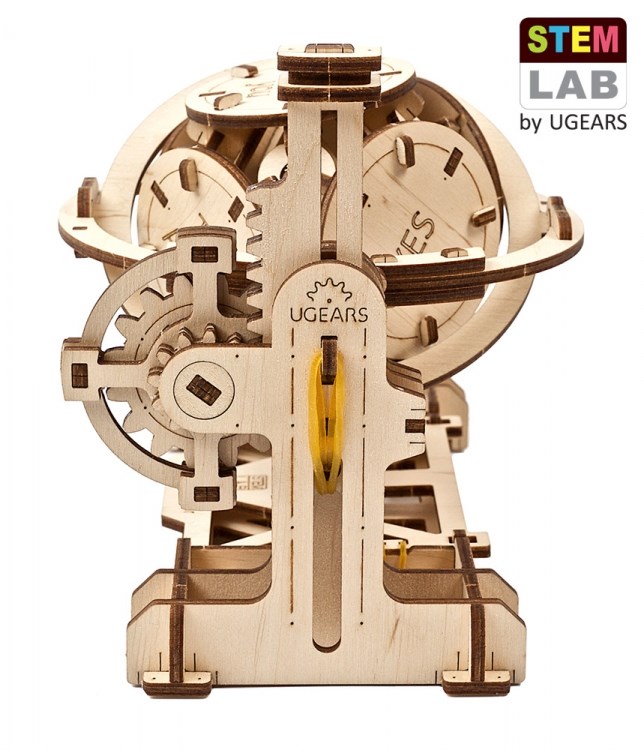Produkt information
Gennemført teknisk model bestående af laserskårne træplader, der er samlet til en mekanisk terning, der giver dig en tilfældig besked som: "Ja", "nej", "gør det nu" osv. Mekanismen består af træ, vægte og kobling som i det hele er involveret i at beslutte din skæbne. Skal du vaske op i dag? Hvem ved...
PS! Produktet kan afvige fra videoen.
Læs mereKlippet er tilføjet som relevant information til produktet, men er ikke nødvendigvis identisk. Indholdet i en produktvideo, testvideo eller anmeldelse kan afvige fra det produkt, der sælges. Dette kan gælde farver, specifikationer, versionsforskelle, regionale forskelle mv. Det er produktets navn, beskrivelse og billeder, du skal forholde dig til ved køb af varen.
OK
PS! Produktteksten er maskineoversat fra norsk.
Der medfølger detaljeret brugermanual, der er også en konstruktionsvideo, se under "Video".
Specifikationer| Modelstørrelse | 17,3 X 12 x 13,2 cm |
| Antal dele | 160 |
| Estimeret byggetid | 3-4 Timer |
| Nødvendige værktøjer | Nul og intet ekstra! |
| Svar muligheder | Ja/Nej/Gør det nu/Prøv igen/Senere/Bør ikke fortælle dig det |


Product details in english
Find out about the Random Generator and learn how it works
For generations, humanity has been futilely wrestling with perennial questions, such as whose turn is it to take out the rubbish? Who will hoover today? And, of course, who does the dishes?
Those who volunteer to do all these chores have our eternal respect, but what if no one volunteers? The fair way to handle this would be to let chance decide and throw a coin. If you have ever bet on heads or tails, this means you got close and personal with probability theory and its practical application.
Ugears suggests an alternative to the classic coin solution that is not only elegant and fun but has an extra educational benefit. To all the questions there is now an answer with Ugears Random Generator of the STEM lab Collection.
The Random Generator, as you might have guessed from its name, is a device that generates random numbers and provides different random results based on probability theory. How it does this is exactly what the Ugears STEM model will demonstrate.
The main element of the Random Generator?s design is a cube with an octahedron inside it that in its turn contains a metal ball to provide weight. This construction is powered by a rack-and-gear drive initiated manually and providing energy through a driven gear that rotates a three-axle gear. This is how the cube with all its contents begins to move, which is important for summoning the magic of randomness. Of course, we can only call it magic until we know the science of it. And to learn it, let us take a closer look at the main structure.
The vertices of the octahedron coincide with the sides of the cube. In this way as the energy of the system expires and it stops moving, gravity suspends the metal ball in the lowest part of the octahedron and due to the inclination of the walls it rolls within, it ends up in one of the octahedron?s vertices pulling in down. Whichever of the vertices turns up in the bottom, the side of the cube it is attached to will be right under it and parallel to the floor. In this way, the side of the cube with the answer will be the one facing up on the opposite side.
The probability to get any of the vertices facing down is virtually the same due to symmetry of the octahedron that rotates freely around the axis of its mass. This leads us to a simple conclusion that the probability to receive one of six answers is 1/6 or 0.167.
Every side of the cube positioned by the vertex of the octahedron, has a message: one says ?YES?, the other ?TRY AGAIN?, etc.
* An octahedron is a regular polyhedron with eight faces (equilateral triangles) and six vertices.
Mere info på engelsk
Dele
Find nemt delene
Dette produkt har PartFinder
Partfinder er designet til at gøre det så nemt som muligt at finde den rigtige del til produktet ved hjælp af eksploderede billeder og/eller styklister.
Åbn PartFinder
c
Dele du savner? Klik her!